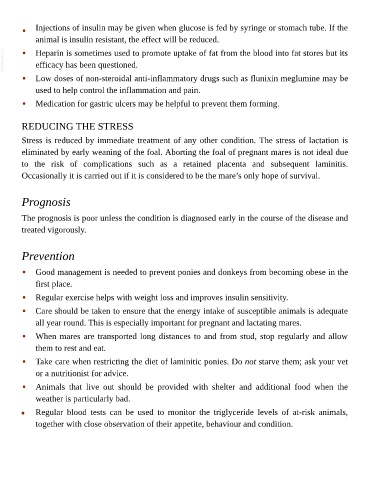Page 796 - The Veterinary Care of the Horse
P. 796
• Injections of insulin may be given when glucose is fed by syringe or stomach tube. If the
animal is insulin resistant, the effect will be reduced.
VetBooks.ir • Heparin is sometimes used to promote uptake of fat from the blood into fat stores but its
efficacy has been questioned.
• Low doses of non-steroidal anti-inflammatory drugs such as flunixin meglumine may be
used to help control the inflammation and pain.
• Medication for gastric ulcers may be helpful to prevent them forming.
REDUCING THE STRESS
Stress is reduced by immediate treatment of any other condition. The stress of lactation is
eliminated by early weaning of the foal. Aborting the foal of pregnant mares is not ideal due
to the risk of complications such as a retained placenta and subsequent laminitis.
Occasionally it is carried out if it is considered to be the mare’s only hope of survival.
Prognosis
The prognosis is poor unless the condition is diagnosed early in the course of the disease and
treated vigorously.
Prevention
• Good management is needed to prevent ponies and donkeys from becoming obese in the
first place.
• Regular exercise helps with weight loss and improves insulin sensitivity.
• Care should be taken to ensure that the energy intake of susceptible animals is adequate
all year round. This is especially important for pregnant and lactating mares.
• When mares are transported long distances to and from stud, stop regularly and allow
them to rest and eat.
• Take care when restricting the diet of laminitic ponies. Do not starve them; ask your vet
or a nutritionist for advice.
• Animals that live out should be provided with shelter and additional food when the
weather is particularly bad.
• Regular blood tests can be used to monitor the triglyceride levels of at-risk animals,
together with close observation of their appetite, behaviour and condition.

